Contents
More and more gardeners and small farmers are realizing that growing blackberries is much more profitable than raspberries. Of course, these species are not identical, but they are very close in biological terms, their taste is similar, and the scope of use is the same. But blackberries are more prolific, less sick and affected by pests, and contain more nutrients than raspberries.
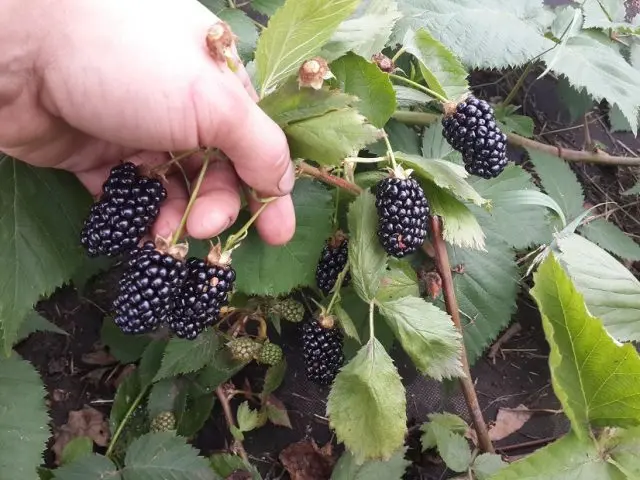
Everyone knows that ideal varieties of fruit crops, including blackberries, do not exist. But gardeners are in constant search. Some have found “their” ideal among the old varieties, many are closely following the latest. The next contender for the title of the best now is the Natchez thornless blackberry. Let’s see if the laudatory comments are true.
History of breeding
The first steps in developing the Natchez blackberry were taken in 1998, when the Ark.1857 and Ark.2005 hybrids were cross-pollinated at the Arkansas Institute. Seedlings were harvested in 2001. Of these, the most promising were selected, and after a six-year test, in 2007, the Ark.2241 sample was patented under the name Natchez.
Description of berry culture
Today, the Natchez variety has taken one of the leading positions in the United States. But do not forget that in America and in the post-Soviet space, the priorities for growing blackberries are different. The main thing for us is productivity and ease of care. And since the culture in Our Country and neighboring countries was previously grown little, only experts and gourmets understand the intricacies of blackberry taste here.
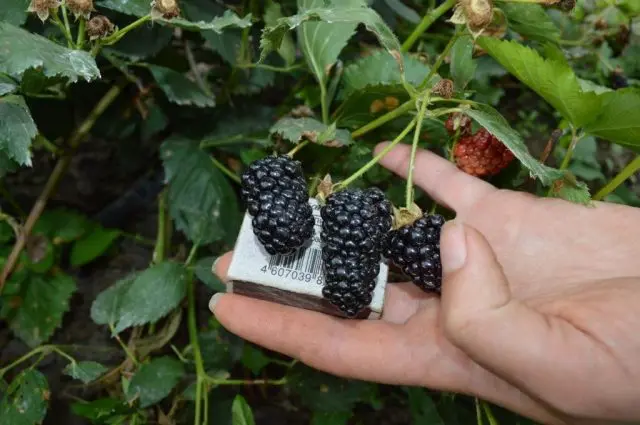
In America, where the consumer is spoiled by an abundance of varieties, it is the tasting qualities and the external attractiveness of the berries that matter most, and not the yield. In addition, the climate there is ideal for growing crops, and there is no need to remove the shoots from the support and cover for the winter.
General idea of the variety
The Black Natchez blackberry is a semi-spreading variety – at first the shoots grow straight, like a bramble, then they turn into a horizontal position and become like a dewberry. An adult bush is powerful, sprawling, with thick lashes 5-7 m in length. In the first year after planting, Natchez blackberry shoots spread along the ground, reach 3-4 m, and only the absence of thorns distinguishes the variety from typical dewberry.
On adult bushes, the lashes grow very quickly, form many lateral branches and fruit twigs. Natchez blackberry leaves are different from other varieties – they are light green, with small notches along the edge and a terry surface.

The root system of blackberries is powerful, and it is the better developed, the more green mass you leave when trimming and rationing lashes. Fruiting occurs on the shoots of the previous year.
Berries
The photo of the Natchez blackberry shows that its fruits are beautiful – black, with a characteristic sheen. They have the shape of an elongated cylinder, on average reach a length of 3,7-4,0 cm and a weight of 9 g. With good care and free planting, individual berries can show 12,7 g when weighed.

On fruit twigs, blackberries are collected in 12-30 pieces. The berries are moderately dense, juicy, but they tolerate transportation perfectly. They attach well to the stalk, the separation is dry, the drupes are small.
The taste of the fruit is very sweet, the acid is almost not felt, the tasting score is 4,6 points. The rating of domestic gardeners gave the variety Natchez 4,3 points. However, the quality of the berries of this blackberry is strongly influenced by external factors, the care and composition of the soil. Gourmets claim that the fruits of the first harvest have a subtle flavor of good coffee.
Characterization
Gardeners’ reviews of the Natchez blackberry show its superiority over other cultivars. It would seem that here it is – the perfect dessert variety. But there is no need to rush. Only those who will choose blackberries with maximum information will not be disappointed. Therefore, we advise you to read this chapter carefully.
Main advantages
Natchez is not a drought-resistant variety. However, the whole culture is moisture-loving and requires regular watering. The bush endures the heat well, but the berries at a temperature higher than 35⁰ C require shading.
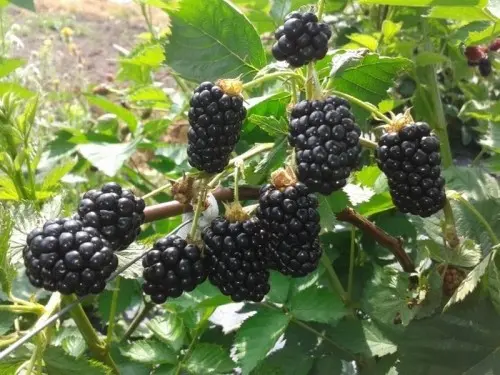
The winter hardiness of the Natchez blackberry is also not the best. It tolerates frost no more than -14⁰ C. Moreover, the shoots keep low temperatures well, but the flower buds freeze out. However, the Natchez blackberry grows green mass very quickly and recovers. But a frozen bush will not give a harvest, so it will have to be covered even in the southern regions.
But the transportability of Natchez berries is high, which is rare for blackberries with juicy fruits. There are no spines on the shoots.
Growing blackberry Natchez requires some effort, you can’t call it unpretentious. The choice of soil should also be approached responsibly – not only the quantity, but also the quality of the berries depends on this.

Flowering period and ripening period
Blackberry variety Natchez is one of the earliest. Depending on the region, it blooms from mid to late May. Fruiting is extended, lasts 35-40 days, sometimes longer. The beginning of ripening of berries depends on the climate, in the south it is mid-late June. Blackberry Natchez in the Moscow region ripens by mid-July.
Yield indicators, fruiting terms
Natchez blackberry yields are the highest among Arkansas’ dessert varieties. From one adult bush you can collect 15-20 kg of berries. Given the early fruiting and lack of thorns, Natchez is close to ideal.

But not everything is as simple as enthusiasts would like. Replacement shoots from Natchez blackberries are poorly formed. Therefore, to obtain a high yield, it is grown in a two-year cycle. This means that in the fruiting season, all young shoots are cut out. In the spring of next year, the bush will be “naked”, it will give more new lashes, but there will be no berries at all.
Scope of berries
Blackberry Natchez belongs to dessert varieties – its berries are tasty, sweet. They are suitable for fresh consumption and desserts. But the preparations from it are obtained “not very” – here the sweet taste of the fruit played a cruel joke, since jams and juices turn out to be “flat” and too cloying. But Natchez blackberries can be used for prefabricated compotes, multijuices and assorted jams.

Disease and pest resistance
Like other blackberries, the Natchez variety is disease resistant and rarely affected by pests. But it is necessary to do preventive treatments, and you need to plant away from nightshade crops, raspberries and strawberries. The ideal distance is at least 50 m, if possible, it should be maintained.
Advantages and disadvantages
Blackberry Natchez has both advantages and disadvantages. However, in other varieties – too, the ideal does not yet exist.
The undeniable advantages include:
- Early ripening berries.
- High yield.
- The berries are large, beautiful, with a high tasting score (4,6 points).
- Transportability and keeping quality of fruits are very good.
- Natchez blackberry lashes produce many side branches and fruit twigs.
- No spikes.
- The variety is resistant to diseases and pests.
- Dry separation of berries.
- Long fruiting.
- The berries are well attached to the stalk, do not crumble. If they are overripe, the taste and commercial qualities do not deteriorate, so that if necessary, the harvest can be delayed. This is especially important for summer residents who come to the site once a week.
- If the bush is still frozen, you can not be afraid to lose the variety – it has a high regenerative ability.
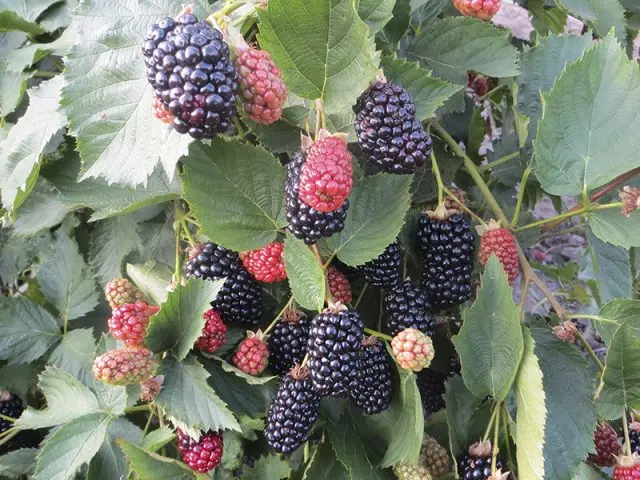
Among the shortcomings should be mentioned:
- Low frost resistance of the variety.
- At temperatures above 35⁰, the fruits are baked.
- Natchez blackberry shoots do not bend well, besides, they can not only break, but also crack.
Methods of reproduction
Unlike other blackberries, the Natchez variety does not propagate well from root cuttings. They need to be dug in the fall, stored in the sand under certain conditions, and planted only in the spring. The variety gives few replacement shoots, to say nothing of shoots, this method is also not suitable for amateur gardeners.
Exit – layering and pulping (rooting of the tops of the shoots). These propagation methods are available in any garden plot, even for beginners. The main thing here is not to forget to water the buried branches.
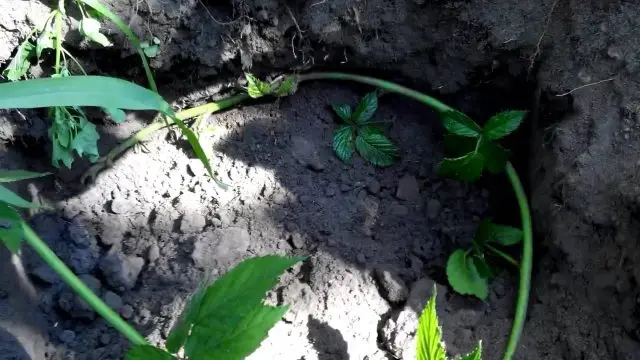
Rules of landing
The Natchez variety is planted in the same way as other blackberries. But he makes increased demands on the soil, so just digging a seedling on the site will not work.
Recommended dates
In the south, blackberries are planted in autumn, but no later than a month before the expected frost, so that the young plant has time to take root. In regions with a temperate and cool climate, earthworks are carried out in the spring, when the soil warms up. Then, before the onset of winter, the blackberry will have time to take root on the site.
Choosing the right place
The place for Natchez blackberries is chosen sunny, protected from the wind. Shading will be required in the south in the middle of summer. Nearby should not be nightshade crops, raspberries and strawberries.
The blackberry soil is slightly acidic, better – loose fertile loam. On sandy soil, the Natchez variety should not be planted. Groundwater should not be located closer than 1-1,5 m from the surface.
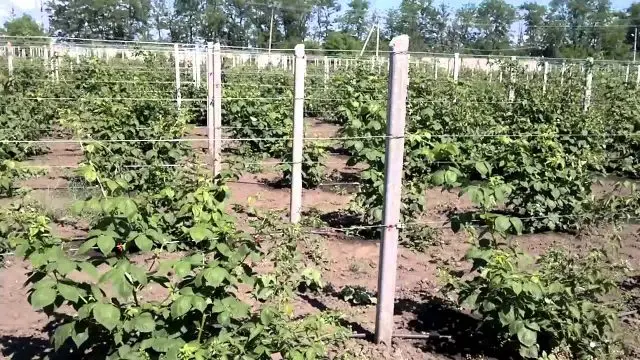
Soil Preparation
The Natchez variety needs pre-planting soil preparation more than other blackberries. Pits are dug for at least 10-14 days, with a depth and diameter of 50 cm. The nutrient mixture is prepared from the topsoil, a bucket of humus, 60 g of potassium, 120-150 g of superphosphate.
But the Natchez variety makes higher demands on the calcium content in the soil. It is better not to add calcium nitrate when planting; dolomite flour or ordinary eggshell will do. But calcium reduces the acidity of the soil, so riding (red) peat should be included in the planting mixture.
If the soil is sandy, more organic matter is added to it. Excessive acidity of the soil is neutralized by dolomite flour (in this case, it is preferable to lime). Sand is added to the dense earth. The neutral or alkaline reaction of the soil is balanced by acidic (red) peat.
Selection and preparation of seedlings
Natchez blackberry seedlings should be bought in trusted retail chains or directly in the nursery – the variety is relatively new, but there are many who want to buy it. There is a high probability that they will sell you not what you need “from the hands”.

Natchez blackberry shoots are devoid of thorns. They must be elastic, without cracks, stains or other damage. One of the signs of a healthy root system is the pleasant smell of fresh earth. Naturally, it should be well developed, without signs of fungi or decay, the processes should be good and easy to bend.
Before planting, blackberries bought in a container are watered. The bare root is soaked in water overnight.
Algorithm and landing scheme
For Natchez, compacted planting is undesirable. This blackberry forms a powerful shrub with well-developed roots, thick shoots and many side branches. The best distance between plants is 2,7-3 m (2-2,5 m is allowed in industrial plantings).
With compaction up to 1-1,5 m, strict rationing of shoots and enhanced blackberry nutrition will be necessary. But experienced gardeners say that this leads to a decrease in yield from a bush, so planting at a distance closer than 2 m between plants does not justify itself. In addition, the quality of berries with strong compaction drops significantly.

Landing sequence:
- A hole is prepared for blackberries, 2/3 filled with a nutrient mixture and completely filled with water. Let stand 10-14 days.
- In the center of the planting hole, a mound is formed, around which blackberry roots are spread.
- The seedling is covered with a nutrient mixture, constantly compacting it. The root neck should be buried 1,5-2 cm.
- Blackberries are watered abundantly, and the soil is mulched with humus or sour peat.
Culture aftercare
The first time after planting, blackberries are often and abundantly watered, preventing the soil from drying out.
Growing principles
Blackberry Natchez must be tied up. Most often, a three-row trellis 1,7-2 m high is used. Since the variety is grown in a two-year cycle, the shoots will not be divided into fruit-bearing and young ones, they do not need to be bred in different directions. This greatly simplifies the garter.
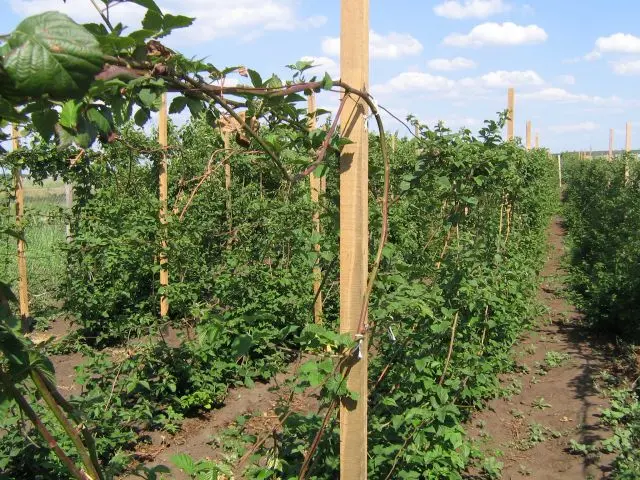
It is necessary to accustom the lashes to lifting on a support and shelter for the winter from the moment they appear. As soon as the shoots reach 15-20 cm, they are bent to the ground and pinned. When the whips grow up, it will be easier to tie them up.
The Natchez variety is usually loaded with berries and forms an overly dense shrub. If the plant is poorly fed and pruning is neglected, the fruits simply will not ripen – they will not have enough nutrients and sun.
Necessary activities
Blackberry Natchez is watered often and plentifully in summer. In the absence of precipitation, an adult bush needs 4-5 buckets of water once a week. During the formation of ovaries and fruiting, watering is done every 3 days, spending 20-30 liters per plant.
Variety Natchez needs abundant top dressing. In spring, the plant needs nitrogen. It is best to use calcium nitrate. During the period of flowering and fruit formation, blackberries are given a complete mineral complex with an obligatory calcium content.
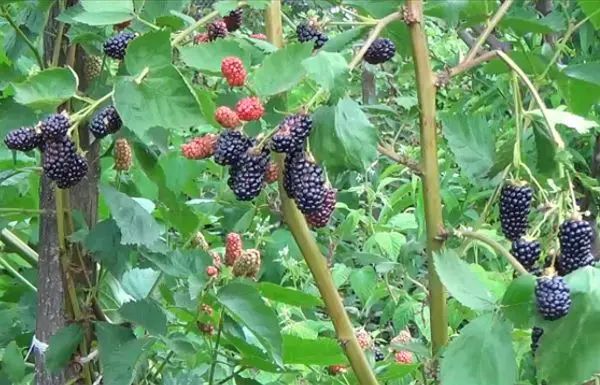
During fruiting, it is advisable to do additional feeding with a solution of mullein infusion or grass. They are bred in proportions of 1:10 and 1:4, respectively. Foliar top dressings with the addition of humate and chelates are useful, which prevent chlorosis and improve the taste of berries. In early autumn, the Natchez variety is fertilized with potassium monophosphate.
In spring and autumn, the soil around the blackberry is loosened. During the period of flowering and fruiting, it is mulched – this will prevent the evaporation of moisture, serve as additional fertilizer and protect the root system from overheating.
shrub pruning
Blackberry Natchez is recommended to be grown as a crop that bears fruit every 2 years. This is due to the fact that the variety does not produce replacement shoots well. In the year of fruiting, all young lashes are cut out. Next year there will be a sufficient number of them, leaving 6-8 of the strongest.
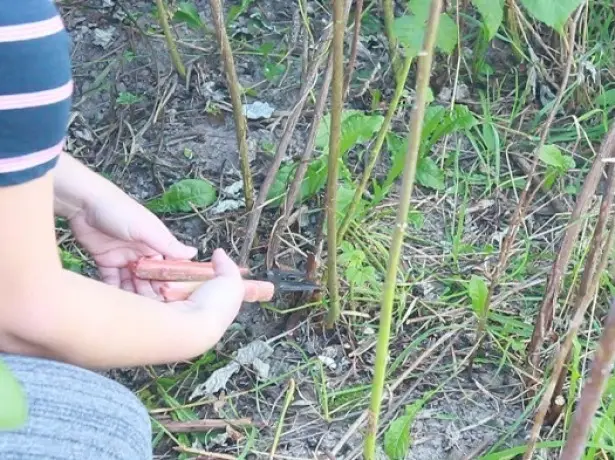
Often, blackberry shoots at a height of 1-1,5 m are pinched to enhance lateral branching. The Natchez variety does not need to do this – it bushes well without it. But the lateral growth is shortened to 30 cm (unlike other varieties, which leave 40 cm). This will avoid a strong overload of berries and increase their size.
After fruiting, old shoots are removed. Sanitary pruning of the Natchez blackberry is carried out throughout the year – all broken, dried and thin branches are removed.
Collection, processing, storage of crops
Many varieties of blackberries differ in that the berries need to be picked frequently, immediately upon reaching maturity. Overripe fruits quickly deteriorate in taste, often become soft and lose their transportability. Not that kind of Natchez. Berries do not lose commercial qualities within 5 days after full ripening and are transported without deforming.
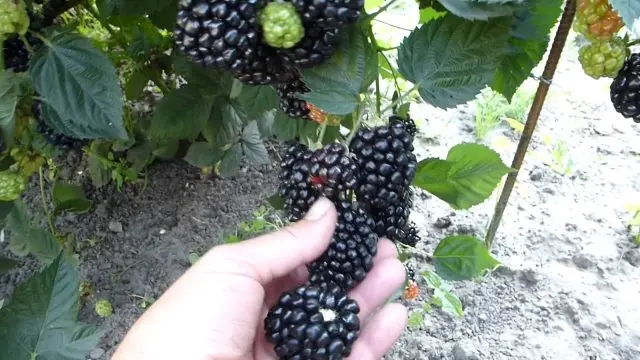
Blackberry Natchez fruits are best eaten fresh, used for baking or desserts. Billets from them are too sweet, cloying. But if they are used in conjunction with other, more acidic fruits and berries, you will get delicious juices, jams and wines.
Preparation for winter
Unlike other blackberries, the Natchez variety begins to be winterized in September or October (depending on the region). At this time, young shoots have not yet fully matured and remain flexible. They are bent to the ground and pinned. Shelter is built just before the onset of frost. Use spruce branches, straw, dry corn stalks. Blackberry Natchez has low frost resistance, so the structure must be covered with spandbond or agrofibre from above.
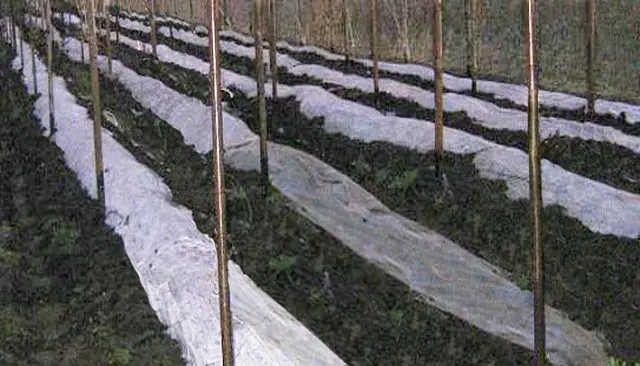
Diseases and pests: methods of control and prevention
Blackberry Natchez rarely gets sick and is little affected by pests. But for the purpose of prevention in spring and autumn, the bush should be sprayed with preparations containing copper, and all foliage and cut shoots should be immediately removed from the site.
Conclusion
As you can see, the Natchez blackberry has both positive and negative sides. There is no perfect variety, but this one came closer to perfection than others. The main advantage of Natchez is the combination of high yield and excellent taste of berries.










